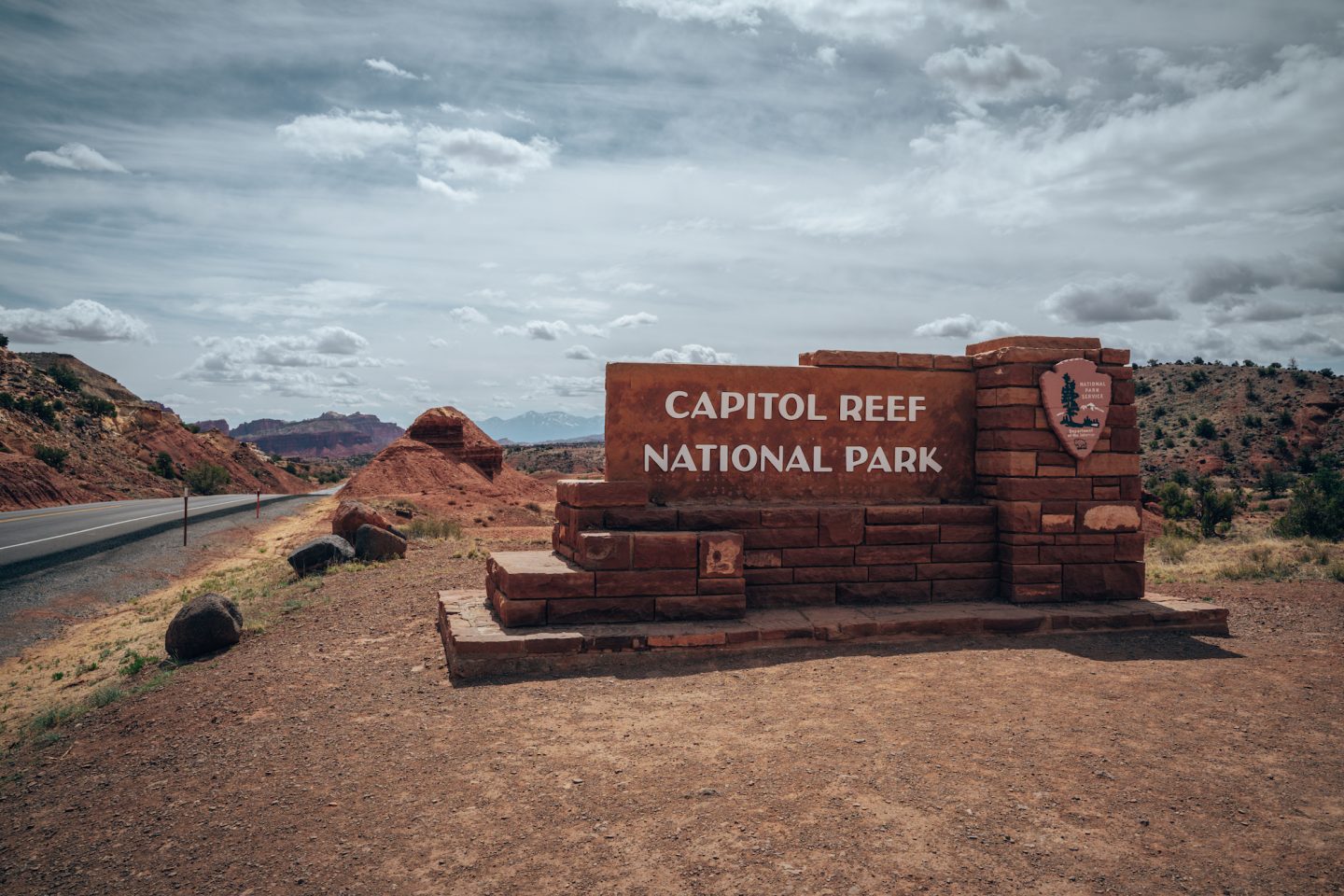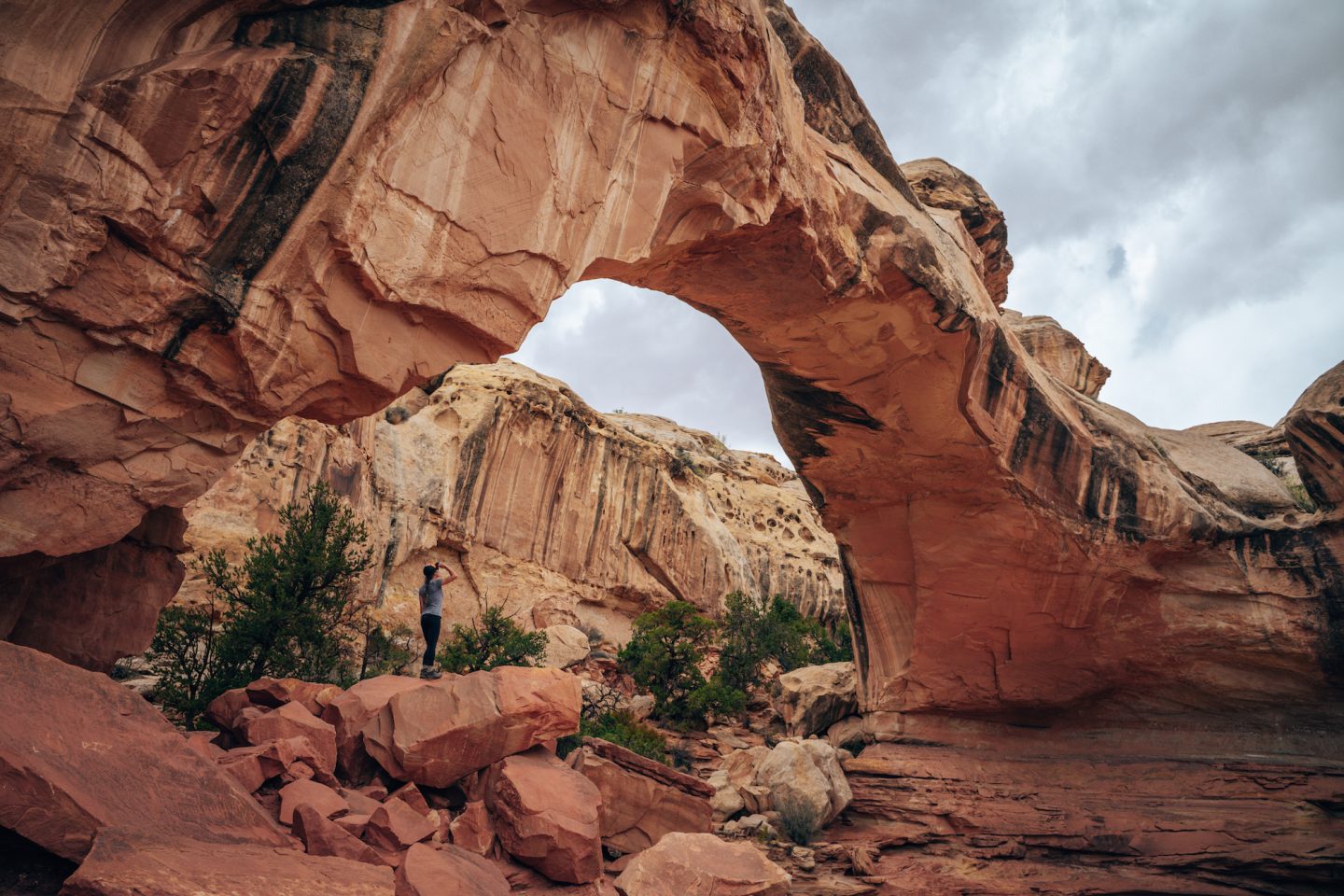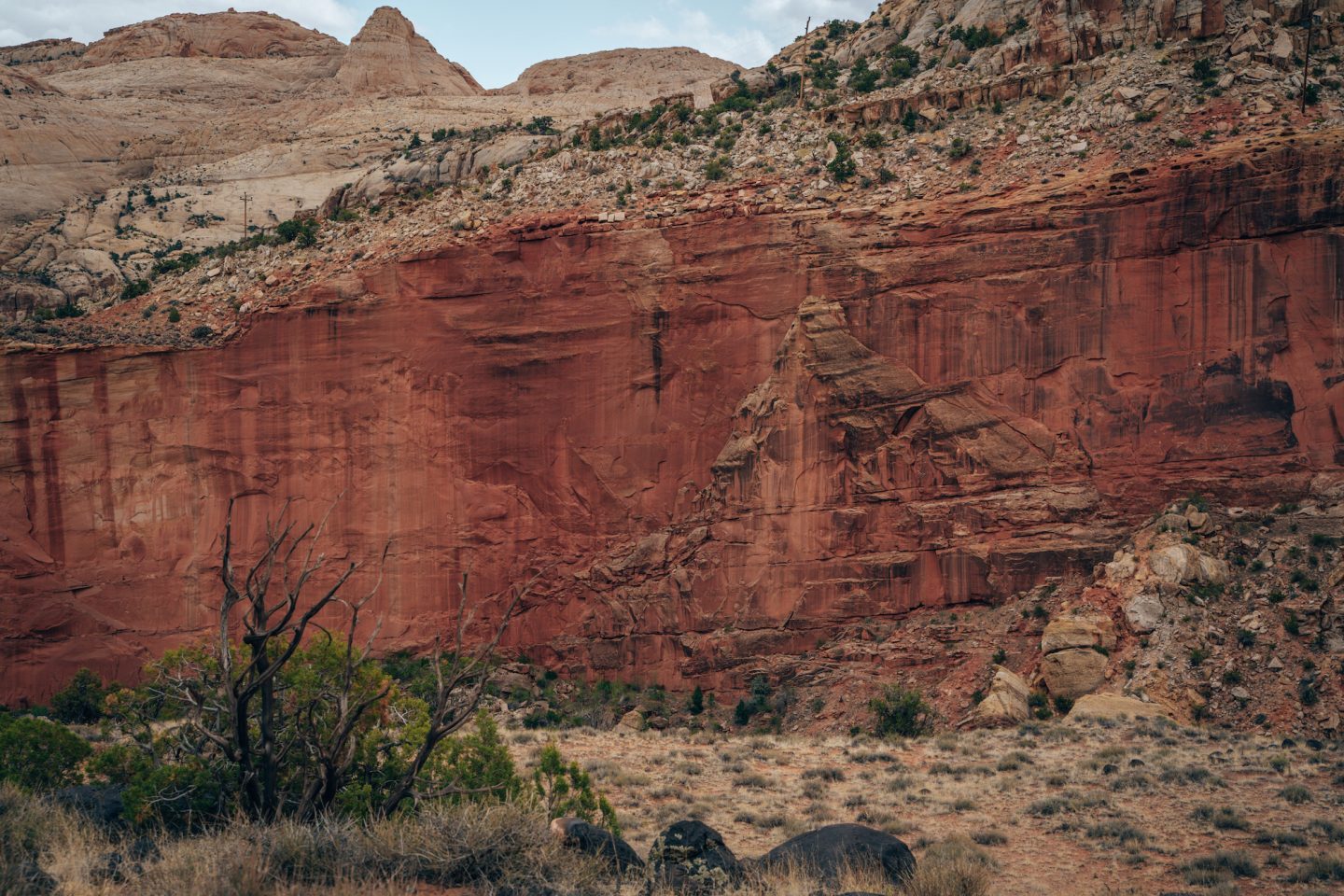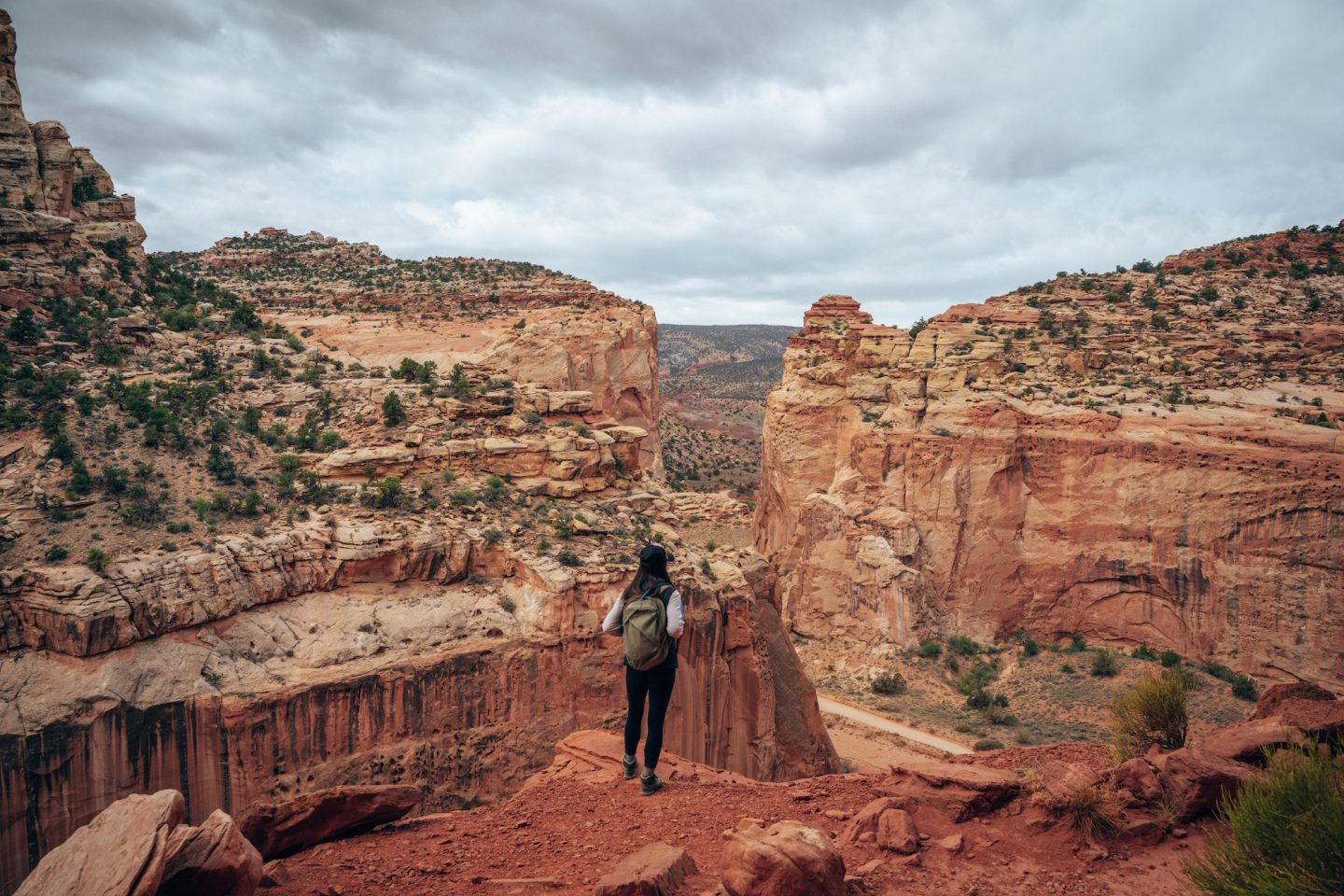
Nestled amidst the stunning red rock formations of southern Utah, Capitol Reef National Park is a hidden treasure waiting to be discovered. With its towering cliffs, scenic drives, and rich geological history, this lesser-known gem offers a serene and awe-inspiring escape from the hustle and bustle of everyday life. Join us as we embark on a journey to explore the captivating landscapes and hidden wonders of Capitol Reef National Park, and why it might just be our favorite of the five National Parks in Utah.
ABOUT CAPITOL REEF NATIONAL PARK
Capitol Reef National Park, boasts a rich and diverse history that dates back thousands of years. The region was once home to Native American cultures, including the Fremont and Ancestral Puebloans, who left behind a remarkable legacy in the form of petroglyphs, pictographs, and ruins. These ancient inhabitants thrived in the area for centuries, utilizing the fertile land and water sources provided by the Fremont River.

European explorers arrived in the 19th century, and the area became known as the “Wayne Wonderland” after explorer and politician Wayne Aspinall. The striking landscape of cliffs, canyons, and domes captivated visitors, and efforts were made to preserve the unique natural features. However, it wasn’t until December 18, 1971, that Capitol Reef National Park was officially established, encompassing over 240,000 acres of stunning geological formations, orchards, and historic sites. The park’s name is derived from its resemblance to the United States Capitol dome and the rugged reef-like cliffs that impeded early settlers.
Today, Capitol Reef National Park offers visitors an opportunity to explore its diverse ecosystems, hike scenic trails, and experience the remnants of its rich human history. From the iconic Waterpocket Fold, a 100-mile-long wrinkle in the Earth’s crust, to the picturesque Capitol Dome and Cathedral Valley, the park’s geology is a testament to millions of years of geological processes. Whether wandering through the historic Fruita orchards, marveling at the rock art left by ancient civilizations, or embarking on a scenic drive along the park’s main road, visitors to Capitol Reef National Park are treated to an unforgettable journey through time and nature.
WHERE IS CAPITOL REEF NATIONAL PARK LOCATED?
Capitol Reef National Park is situated in south-central Utah. It is part of the larger region known as the Colorado Plateau, which encompasses stunning landscapes across several states. The park’s location is approximately 150 miles south of Salt Lake City and about 70 miles southeast of Bryce Canyon National Park. Capitol Reef National Park is easily accessible via Utah State Route 24, which cuts through the park and provides visitors with awe-inspiring vistas of the surrounding red rock formations. Its strategic position amidst the canyon country of southern Utah makes it an ideal destination for those seeking natural beauty and outdoor adventures in this captivating region.
DRIVE TIME FROM:
- Salt Lake City – 3.5 hours
- Las Vegas – 5 hours
- Albuquerque/Santa Fe – 7.5 hours
- Phoenix- 8 hours
- Los Angeles – 9.5 hours
CLOSEST AIRPORT:
The closest major airport to Capitol Reef National Park, would be Salt Lake City International Airport (SLC), with a drive of around 3.5 hours to the park. Being situated right in the middle of the other 4 National Parks in Utah, if you plan to visit this park, we highly recommend adding Bryce Canyon or Canyonlands National Parks to your itinerary. And if you have a lot of time, Goblin Valley State Park is worth a visit as well!
MAP OF THE CAPITOL REEF NATIONAL PARK
ENTRY TO CAPITOL REEF NATIONAL PARK

ENTRANCE FEES
Good news! No reservations or timed entries required! However, parking can be quite limited throughout the park, so even during non-peak seasons, it can get quite busy and full.
There is one visitor center in the park near the Fruita Campground off the main Hwy 24 that runs through the park. Parking is VERY small and limited there, so plan to go early or late.

Capitol Reef National Park has a standard fee of $20 per vehicle, which is good for 7 days, no matter the time of year you are visiting. If you are someone who lives in Utah or the neighboring areas, and would like to visit Capitol Reef often, they do have a $35 annual pass that you can get as well. You can view all the entry and pass options HERE. That being said, for an extra $10, you can get the America The Beautiful Annual Pass.
If you are someone like us who is either on a mission to visit every single National Park in the U.S., or plans to visit more than 2 or 3 U.S. national parks per year, then we’d highly recommend getting the America The Beautiful Pass. For $80, this annual pass gives you full access to all 63 National Parks in the U.S., as well as any federal recreational sites that charge a fee for entry. Stay at 3 National Parks and this easily pays for itself.
WHERE TO STAY IN CAPITOL REEF NATIONAL PARK

When visiting Capitol Reef National Park, there are several options for accommodations that cater to different preferences and budgets. The park itself offers the Fruita Campground, which provides a rustic camping experience with tent and RV sites, along with basic amenities.
For those seeking more comfort, the nearby town of Torrey, just outside the park’s entrance, offers a range of lodging options including hotels, motels, and bed and breakfast establishments. Some of these accommodations provide stunning views of the surrounding landscapes, allowing you to wake up to the beauty of Capitol Reef. Additionally, there are also vacation rentals and guest ranches available in the area for those who prefer a more secluded or unique lodging experience.
Whether you’re looking to camp under the stars or enjoy the comforts of a cozy hotel, there are plenty of choices to make your stay at Capitol Reef National Park both memorable and comfortable.
You can learn more about places to stay in Capitol Reef National Park HERE.
HARVEST HOST
Do you have a RV or a camper? Then Harvest Hosts is easily the best $100 spent. Harvest Host is a network of over 2,500 locations around the U.S., Canada and Mexico that allow you to stay at overnight. The best part? These locations are wineries, breweries, farms, museums and more! Imagine opening the door to your camper or RV to morning views over a vineyard. Or sipping delicious beer at a local brewery. This is the life you could be living. So if you aren’t already a member, trust us, click on the banner and sign up!
BLM AND FREE CAMPING SPOTS
If you’re a van lifer, or someone who would prefer to spend time on free land outside the park, we have good news! There are a number of locations just outside the park that offer free dispersed camping making it easy to get in and out of the park. Make sure to take a look at our map above for exact locations.
THINGS TO DO IN CAPITOL REEF NATIONAL PARK
SCENIC DRIVE

One of the BEST ways to experience Capitol Reef National Park, is by simply driving and exploring the scenic drives. Embarking on scenic drives such as the Capitol Reef Scenic Drive or the Cathedral Valley Loop allow you to view some of the most breathtaking and expansive landscapes in the park. You’ll also find a number of scenic overlooks allowing you to capture awe-inspiring panoramic views from iconic spots like Sunset Point and Panorama Point. These vantage points provide stunning vistas of the park’s colorful cliffs and expansive landscapes.
HIKES
Lace up your hiking boots and hit the park’s numerous trails. Whether you’re a soft adventurer like us, or someone looking for those more challenging hikes, there are trails with incredible views for you. And each trail offers a unique perspective and showcases the park’s natural beauty up close.
FRUITA TRAIL
The only pet friendly trail in the park, Fruita Trail begins at the visitors center, and runs along the Scenic Drive Rd to the Fruita Campground. The out and back trail is a combination of red dirt and paved sidewalks, and is very flat and accessible. A great trail to start your visit in the park!
- DIFFICULTY – Easy to moderate
- LENGTH – 3.1mi / 4.9km loop
- PET FRIENDLY – Yes
- SOFT ADVENTURE APPROVED – Yes
PIONEER REGISTER (CAPITOL GORGE)

While this trail if completed start to finish is 4.5 miles long, the main attraction of the trail is the Pioneer Register, which is only 0.5mi in to the hike. On the north side of the canyon wall, are names and dates that were carved, painted and even shot in to the canyon wall. According to the National Park Service, “Prospectors, explorers, surveyors, cowboys, area settlers, and early visitors would often stand on their wagons to carve their names into the canyon wall. They were leaving their mark above flash flood danger, likely hoping their names would survive for centuries.”.

- DIFFICULTY – Easy to moderate
- LENGTH – 4.5mi / 7.2km loop
- PET FRIENDLY – No
- SOFT ADVENTURE APPROVED – Yes
CASSIDY ARCH

When you think of natural arches or bridges, you probably think of one of Capitol Reef’s relative parks, Arches National Park. Truth be told, natural arches and bridges can be found all over Utah and other neighboring states. Cassidy Arch in our minds, is one of the highlights of Capitol Reef, and offers absolutely stunning and incredible views, even before you reach the arch itself. But the elevation gain on this trail is significant, so if you’re looking for soft adventures only, you may want to reconsider doing this hike. But if you’re up to the challenge, we would HIGHLY recommend this hike.
- DIFFICULTY – Moderate to hard
- LENGTH – 3.1mi / 4.9km loop
- PET FRIENDLY – No
- SOFT ADVENTURE APPROVED – No
HICKMAN BRIDGE

Speaking of natural bridges! Hickman bridge is a perfect alternative if you aren’t feeling up to the challenge of doing Cassidy Arch. This trail is nearly half the length of Cassidy Arch, and much flatter. And while you cannot walk on or stand on the bridge, you can walk beneath it. This is a perfect hike for those short on time in the park.
- DIFFICULTY – Easy to moderate
- LENGTH – 1.7mi / 2.7km
- PET FRIENDLY – No
- SOFT ADVENTURE APPROVED – Yes
OTHER TRAILS & AREAS

There are a TON of hiking trails in and around Capitol Reef National Park. The four above, and those listed below are the more popular and common trails. But if you’re looking for more or different options, check out the NPS website for more info HERE.
- Chimney Rock
- Grand Wash
- Cathedral Valley
STARGAZING
Experience the awe-inspiring night skies of Capitol Reef. The park is designated as an International Dark Sky Park, offering exceptional opportunities for stargazing. Attend one of the park’s astronomy programs or simply find a secluded spot to gaze at the countless stars above. You will not regret it.
ROCK CLIMBING, BOULDERING & CANYONEERING
For thrill-seekers and experienced adventurers, rock climbing, bouldering, and canyoneering in Capitol Reef are exhilarating options. Explore the narrow slot canyons and enjoy the challenge of rappelling, scrambling, and navigating through this stunning terrain.
HORSEBACK RIDING

This is something we never expected to do ourselves, but during a visit to Bryce Canyon, we had the opportunity to do a horseback riding tour thanks to Tinggly (we’ll cover what Tinggly is below!). It was absolutely an unforgettable experience and one that we would highly recommend!
FRUITA HISTORIC DISTRICT

One of the most unique aspects of Capitol Reef National Park, is the greenery inside the valley of the park. From towering trees, to beautiful orchards. Not things you’d expect from such a red rock desert area. Immersing yourself in the history of the park at the Fruita Historic District is a great way to learn more about the park and the landscape. You can stroll through an orchard filled with historic fruit trees and visit the preserved pioneer buildings, including a schoolhouse and blacksmith shop. There is even a pie shop where you can purchase freshly baked pies! Trust us, it’s worth it.

If you visit during the harvest season (usually from June to October), indulge in a unique experience by picking fresh fruit from the historic orchards in Fruita. Enjoy the flavors of apples, cherries, peaches, and more.
OTHER ACTIVITIES
There are a ton of things to do in this park. And if none of the above catches your interest, you’ll also find ranger led programs, snowshoeing and cross-country skiing in the winter, geology talks, wildlife spotting and more. To see all the different things you can do in this park, go HERE.
TINGGLY EXPERIENCES
We mentioned Tinggly above… Looking to do something more fun, or unique? If you aren’t familiar with Tinggly, they are a company based on gifting experiences over stuff. Helicopter tours, sunset cruises, horseback riding, ATV tours, and so so much more. So for that next birthday, or gift-giving holiday, instead of gifting stuff, give the gift of an experience. Memories that will last forever. Click on the banner to check them out, or read our full review of Tinggly HERE.
BEST TIME TO VISIT
The best times to visit Capitol Reef National Park largely depend on personal preferences and the type of experience you seek. Here are the different seasons and their unique characteristics to help you plan your visit:
SPRING
Spring (March to May): Spring is a delightful time to visit Capitol Reef as the temperatures are mild, ranging from pleasant to warm. The park comes alive with vibrant wildflowers, and the fruit trees in the Fruita Historic District blossom, creating a picturesque setting. Spring also offers lower visitor numbers compared to the summer months, allowing for a more tranquil experience. We visited at the beginning and end of May, and found it to be perfect temperatures.

SUMMER
Summer (June to August): Summer brings warmer temperatures to Capitol Reef, with daytime highs ranging from hot to very hot. This is the busiest season due to school vacations, so expect larger crowds. However, summer allows for longer daylight hours, providing ample time for exploration and outdoor activities. Be prepared for hot and dry conditions, and plan hikes and outdoor excursions during the cooler parts of the day.
FALL
Fall (September to November): Fall is often considered one of the best times to visit Capitol Reef. The temperatures start to cool down, making for comfortable hiking and outdoor adventures. The park’s landscapes transform into a kaleidoscope of vibrant autumn colors, creating a stunning backdrop for your visit. Additionally, the crowds begin to thin out, offering a more peaceful experience.
WINTER
Winter (December to February): Winter in Capitol Reef brings colder temperatures and occasional snowfall. The park sees fewer visitors during this season, making it an ideal time for solitude and quiet contemplation amidst the stark beauty of the red rock formations. While some trails may be inaccessible due to snow or icy conditions, winter presents a unique opportunity for photography and capturing the park’s landscapes in a different light.
It’s important to note that weather conditions can vary, and it’s always advisable to check the forecast and road conditions before visiting. Regardless of the season, remember to pack sunscreen, water, and appropriate clothing and gear for outdoor activities. With its diverse landscapes and natural wonders, Capitol Reef National Park offers a captivating experience throughout the year, so choose the time that aligns with your preferences and embark on an unforgettable adventure.
Our recommendation: If you can visit during the spring months, you’ll find fewer crowds, more luscious greenery, and better temperatures.
You can keep up with park updates HERE.

SEASONS
SPRING – (MARCH-MAY)
- Avg Low temps: 37ºF / 3ºC
- Avg High temps: 65ºF / 18ºC
SUMMER – (JUNE-AUGUST)
- Avg Low temps: 60ºF / 16ºC
- Avg High temps: 87ºF / 31ºC
FALL – (SEPTEMBER-NOVEMBER)
- Avg Low temps: 41ºF / 5ºC
- Avg High temps: 65ºF / 18ºC
WINTER – (DECEMBER-FEBRUARY)
- Avg Low temps: 19ºF / -7ºC
- Avg High temps: 40ºF / 4ºC
HOW MUCH TIME IS NEEDED
The amount of time needed to visit and explore Capitol Reef National Park depends on various factors, including your interests, available time, and desired level of exploration. While a single day can offer a glimpse of the park’s beauty, allowing for a scenic drive and a short hike, dedicating more time will allow for a more comprehensive experience. Here are some general guidelines to consider:
DAY TRIP
If you have limited time, you can still get a taste of Capitol Reef National Park. Spend a day exploring the scenic drive and stopping at overlooks to admire the breathtaking vistas. Take a short hike to iconic landmarks such as Hickman Bridge or Capitol Gorge. This timeframe will give you a glimpse of the park’s highlights, but you may not have enough time for extensive exploration or multiple hikes.

OVERNIGHT VISIT
With a more than one day, you can delve deeper into the park’s offerings. Explore additional hiking trails, such as Cohab Canyon or Grand Wash, to immerse yourself in the captivating landscapes. Take time to visit the Fruita Historic District and learn about the area’s history and pioneer heritage. This duration allows for a more relaxed pace and the opportunity to truly appreciate the park’s diverse features.
MULTIPLE DAYS
For those seeking a more immersive experience, spending five or more days in Capitol Reef National Park is ideal. You can further explore the park’s backcountry trails, embark on longer hikes, and potentially engage in activities like canyoneering or multi-day backpacking trips. This timeframe allows you to fully immerse yourself in the park’s beauty and tranquility, uncover hidden gems, and truly connect with the natural wonders and rich history of the area.
Ultimately, the amount of time you choose to spend in Capitol Reef National Park depends on your interests, available time, and desired level of exploration. Keep in mind that the park’s vastness and unique attractions can easily captivate visitors for days. Regardless of the duration, make sure to plan ahead, check trail conditions, and consult the park’s visitor center for the most up-to-date information to make the most of your visit.
OTHER THINGS TO CONSIDER
CELL PHONE SERVICE
Cell phone service inside the park is very spotty, almost non-existent, subject to your carrier. We found that between Verizon and T-Mobile, we had very limited west of the visitor center, but once you go further in to the park, service was non-existent.
We’d highly recommend downloading offline maps, trail info, and make sure to share your plans and itinerary with someone outside of the park in case of emergency.
And if you’re camping in or around the park, we found that Starlink does work well if you can find an open enough space to reduce the risk of any obstructions.
PET FRIENDLY?

Sadly, Capitol Reef is not the most pet friendly park, and this is largely due to the local wildlife and land. Pets are only allowed in the campgrounds, parking lots, paved roads and paved viewpoints areas.
You can find more info on the NPS website HERE.
LEAVE NO TRACE & 10 HIKING ESSENTIALS
This park is full of unique landscapes and fragile environments, both for plant life, and animals alike. So it is incredibly important to practice the 7 Principles Of Leave No Trace, and follow the posted signage and guidelines of the park. If you aren’t familiar with Leave No Trace, here’s a breakdown:
- Plan ahead and prepare
- Travel and camp on durable surfaces
- Dispose of waste properly
- Leave what you find
- Minimize campfire impact
- Respect wildlife
- Be considerate of others
There are additional and more in-depth details of what each of these means on the LNT website, so make sure to take a look at that!
Similarly, because of how harsh the weather conditions can be, and because there is virtually no cell-phone service anywhere, it is important to hike with the 10 Essentials of Hiking. If you aren’t familiar, here’s a breakdown:
- NAVIGATION – maps, guides, compass, GPS locator
- HEADLAMP – flashlight and extra batteries or charger
- SUN PROTECTION – body sunscreen, lip sunscreen, and clothing protection
- FIRST AID – including animal and bug repellents
- KNIFE – as well as knife repair kit
- FIRE – matches, lighter, tinder and striker
- SHELTER – tent, cover, or anything to protect and cover you
- FOOD – snacks and extra meal
- WATER – more than the minimum recommended amount
- CLOTHES – enough to handle night-time elements
Interested in knowing what gear we use for all our adventures? Check out our Rock Porch lockers which list all of the gear we use, and where to shop it!
ULTIMATE GUIDE TO CAPITOL REEF NATIONAL PARK IN UTAH
Let us know what you thought of this, if we missed anything, and if you plan on taking a trek to CAPITOL REEF National Park at some point, down below in our comments!
And if you’re looking for some other Arizona or National Park inspiration, check out some of our other articles:
- ULTIMATE GUIDE TO BRYCE CANYON NATIONAL PARK
- TOP 10 OUTDOORSY THINGS TO DO IN ARIZONA
- VISITING MONUMENT VALLEY IN AZ
- VISITING HORSESHOE BEND IN ARIZONA
- BEST HIKES IN SEDONA ARIZONA
If you aren’t following us on Instagram, then check us out there and give us a follow as this will be the best place to follow our journey and adventures!
Thanks for stopping by!
Ryan & Katy